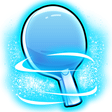Receiving wide-angled serves
Receiving
Andrew Pape Asked 13 years ago
Hi Alois,
I have struggled with receiving serves wide to the f/hand, where the ball hits the table at say mid-depth, and only bounces once, but then drops off the right side of the table. I know this is a problem against left-handers, so I always receive closer to centre of table against them. But the last two opponents have both been right-handers, and I've still had trouble.
I wanted to attack first, but found looping awkward and not a percentage shot. I ended up scrambling around the side of the table, and not just not being able to attack, but actually making it easy for the opponent. In the end, I just pushed the ball back and tried to stay out of trouble.
The next week it was a different opponent, but same problem. I saw an international in action playing against the same serve. He did a slow loop with his f/hand, and then his opponent, being ready, loop-killed the ineffective loop. I'm not a great looper, so if a top player (with a better loop) cannot handle these angled serves, what should I do?
I have also played a leftie a while ago, and he got an advantage serving the ball so it went around the left side of the table. Again, I couldn't attack (with b/hand), and was out of position. The player knew he had an advantage. The right-handed opponent served a forehand to my wide forehand, while the leftie served a forehand wide to my backhand.
Similar problem: hard to attack, hard to play safe, hard not to get out of position. Any ideas?
Cheers,
Andrew.
 Alois Rosario Answered 13 years ago
Alois Rosario Answered 13 years ago
Hi Andrew,
This can be a difficult ball. I find that if you get your footwork right you are half way there. When we step around the corner of the table you can move one foot out wide. If the ball is wide to the backhand you need to move your left leg out as wide as the ball is coming. Similarly if the ball is going wide to the forehand you need to move your right leg wide out to the width of the ball. This one wide step allows you to get back into position easily.
You can let the ball drop but one of the keys here is that you need to make the topspin return either low or spinny or both. Also look to position the ball well. You won't be able to hit the ball fast from that position so placement is vital. I guess it requires a bit of touch to get it right.
Recommended Video
Returning a Heavy Backspin Serve
A lot of players will serve to you with heavy backspin. In this video we show you how to return this effectively.
Watch NowThoughts on this question
Become a free member to post a comment about this question.
Abhinav Upadhyay Posted 11 years ago
Hi Alois,
I have been having trouble with this serve as well. I stand on my backhand corner so that I have all the room available to play forehand topspin. But now my opponents have started to serve really wide to my forehand. Being a left handed, it is very easy for right handed opponents to serve across the court and really wide to my forehand. Should I stand a bit more towards the center line? But then I fear, it will expose my backhand.
Hi Abhinav,
Try to adjust your position depending on the player's stance and their types of serves. If you are finding you are getting caught out wide on the forehand then you should move a little that way.
Andrew Pape Posted 11 years ago
When a practice partner serves balls wide to my left (BH) side, I found the best way to receive them is to take the ball early off the bounce, before it goes around the left side of the table.
The FH side has been more troublesome. I think it's different from the BH because it's further away. I often play a bad loop and leave the table open to get killed next ball. I found that it's best to send the ball back at the same angle to the server, so I'm not out of position, and also giving the server a dose of his own medicine with the angle.
I have a slightly different ready position for each opponent whose game I know. Often this is because the opponent is serving illegally, eg when I see no ball toss and next I see the ball wide on the FH, so have hit in on the run. In that case, I'd receive from the middle of the table.
To Abhinav: from coaching, I (right hander) have been instructed to stand further to the right against any leftie. Watching the pros, some of them take this advice against lefties, and some don't. I guess it depends on what serves you expect to receive.
Cheers,
Andrew.
Abhinav Upadhyay Posted 11 years ago
Hi Alois,
See this clip of a match of Timo Boll. At 4:29 he gets a similar wide serve which has been troubling me. Even he could not get to it ;-)
https://www.youtube.com/watch?feature=player_detailpage&v=Q6jcPz_6IT8#t=267
This was a particularly good serve with good deception wasn’t it. He starts with a very similar position as his previous serves.